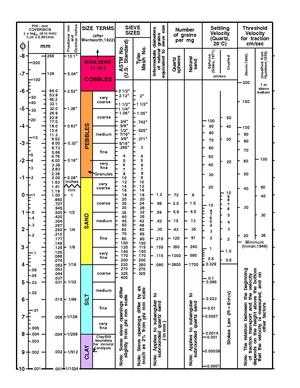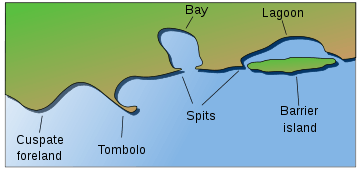Grain size

Particle size, also called grain size, refers to the diameter of individual grains of sediment, or the lithified particles in clastic rocks. The term may also be applied to other granular materials. This is different from the crystallite size, which refers to the size of a single crystal inside a particle or grain. A single grain can be composed of several crystals. Granular material can range from very small colloidal particles, through clay, silt, sand, and gravel, to boulders.
Krumbein Phi Scale-United States
Size ranges define limits of classes that are given names in the Wentworth scale (or Udden-Wentworth) used in the United States. The Krumbein phi (φ) scale, a modification of the Wentworth scale created by W. C. Krumbein[1] in 1937, is a logarithmic scale computed by the equation
where
 is the Krumbein phi scale,
is the Krumbein phi scale, is the diameter of the particle, and
is the diameter of the particle, and is a reference diameter, equal to 1 mm (to make the equation dimensionally consistent).
is a reference diameter, equal to 1 mm (to make the equation dimensionally consistent).
This equation can be rearranged to find diameter using φ:
| φ scale | Size range (metric) |
Size range (approx. inches) |
Aggregate name (Wentworth Class) |
Other names |
|---|---|---|---|---|
| −8 < | 256 mm < | 10.1 in < | Boulder | |
| −6 to −8 | 64–256 mm | 2.5–10.1 in | Cobble | |
| −5 to −6 | 32–64 mm | 1.26–2.5 in | Very coarse gravel | Pebble |
| −4 to −5 | 16–32 mm | 0.63–1.26 in | Coarse gravel | Pebble |
| −3 to −4 | 8–16 mm | 0.31–0.63 in | Medium gravel | Pebble |
| −2 to −3 | 4–8 mm | 0.157–0.31 in | Fine gravel | Pebble |
| −1 to −2 | 2–4 mm | 0.079–0.157 in | Very fine gravel | Granule |
| 0 to −1 | 1–2 mm | 0.039–0.079 in | Very coarse sand | |
| 1 to 0 | ½–1 mm | 0.020–0.039 in | Coarse sand | |
| 2 to 1 | ¼–½ mm | 0.010–0.020 in | Medium sand | |
| 3 to 2 | 125–250 µm | 0.0049–0.010 in | Fine sand | |
| 4 to 3 | 62.5–125 µm | 0.0025–0.0049 in | Very fine sand | |
| 8 to 4 | 4–62.5 µm | 0.00015–0.0025 in | Silt | Mud |
| 10 to 8 | 1-4 µm | < 0.00015 in | Clay | Mud |
| 20 to 10 | 1-1000 nm | < 0.000039 in | Colloid | Mud |
In some schemes, gravel is anything larger than sand (comprising granule, pebble, cobble, and boulder in the table above).
International scale
ISO 14688-1, establishes the basic principles for the identification and classification of soils on the basis of those material and mass characteristics most commonly used for soils for engineering purposes. ISO 14688-1 is applicable to natural soils in situ, similar man-made materials in situ and soils redeposited by man.[2]
| Name | Size range (mm) | Size range (approx. in) | |||
|---|---|---|---|---|---|
| Very coarse soil | Large boulder | LBo | >630 | >24.8031 | |
| Boulder | Bo | 200 – 630 | 7.8740 - 24.803 | ||
| Cobble | Co | 63 – 200 | 2.4803 - 7.8740 | ||
| Coarse soil | Gravel | Coarse gravel | CGr | 20 – 63 | 0.78740 - 2.4803 |
| Medium gravel | MGr | 6.3 – 20 | 0.24803 - 0.78740 | ||
| Fine gravel | FGr | 2.0 - 6.3 | 0.078740 - 0.24803 | ||
| Sand | Coarse sand | CSa | 0.63 - 2.0 | 0.024803 - 0.078740 | |
| Medium sand | MSa | 0.2 - 0.63 | 0.0078740 - 0.024803 | ||
| Fine sand | FSa | 0.063 - 0.2 | 0.0024803 - 0.0078740 | ||
| Fine soil | Silt | Coarse silt | CSi | 0.02 - 0.063 | 0.00078740 - 0.0024803 |
| Medium silt | MSi | 0.0063 - 0.02 | 0.00024803 - 0.00078740 | ||
| Fine silt | FSi | 0.002 - 0.0063 | 0.000078740 - 0.00024803 | ||
| Clay | Cl | ≤0.002 | ≤0.000078740 | ||
Sorting
An accumulation of sediment can also be characterized by the grain size distribution, called sorting. According to a formula[4] the sorting can be quantified as
| φ < 0.35 | 0.35 < φ < 0.50 | 0.50 < φ < 0.71 | 0.71 < φ < 1.00 | 1.00 < φ < 2.00 | 2.00 < φ |
|---|---|---|---|---|---|
| very well sorted | well sorted | moderately well sorted | moderately sorted | poorly sorted | very poorly sorted |
See also
- Orders of magnitude (volume)
- Soil texture
- Substrate (biology)
- Unified Soil Classification System (USCS)
- Martin diameter
- Feret diameter
References
- ↑ Krumbein, W. C.; Aberdeen, Esther (April 1937). "The Sediments of Barataria Bay". Journal of Sedimentary Petrology 7 (1). Retrieved 11 May 2014. (subscription required (help)).
- ↑ iso.org
- ↑ ISO 14688-1:2002 at scribd.com
- ↑ Folk, Robert L.; Ward, William C. (1957). "Brazos River bar: a study in the significance of grain-size parameters". Journal of Sedimentary Petrology 27 (1): 3–26. doi:10.1306/74d70646-2b21-11d7-8648000102c1865d. Retrieved 11 May 2014.
External links
- R D Dean & R A Dalrymple, Coastal Processes with Engineering Applications (Cambridge University Press, 2002)
- W C Krumbein & L L Sloss, Stratigraphy and Sedimentation, 2nd edition (Freeman, San Francisco, 1963).
- J A Udden, "Mechanical composition of clastic sediments", Bull. Geol. Soc. Am. 25, 655-744 (1914).
- C K Wentworth, "A scale of grade and class terms for clastic sediments", J. Geology V. 30, 377-392 (1922).



